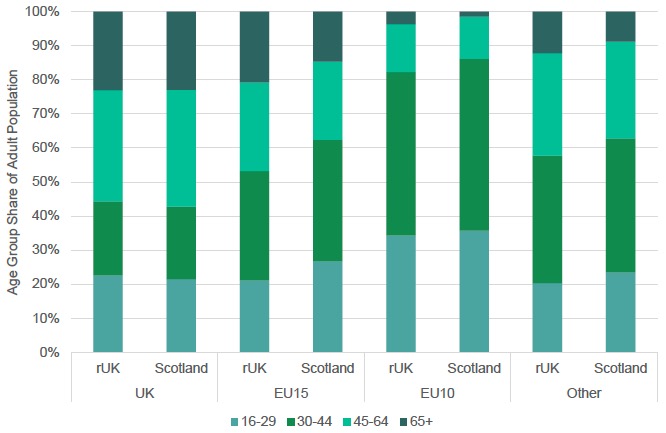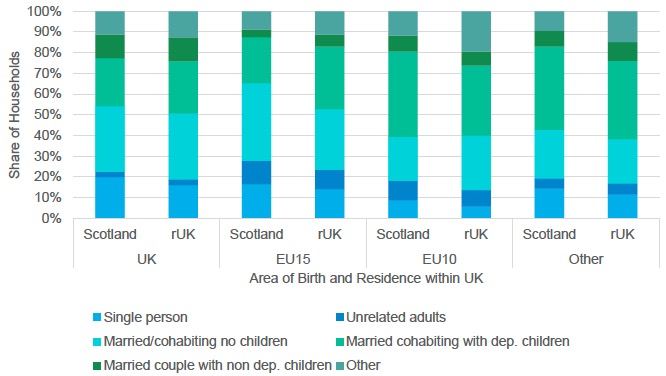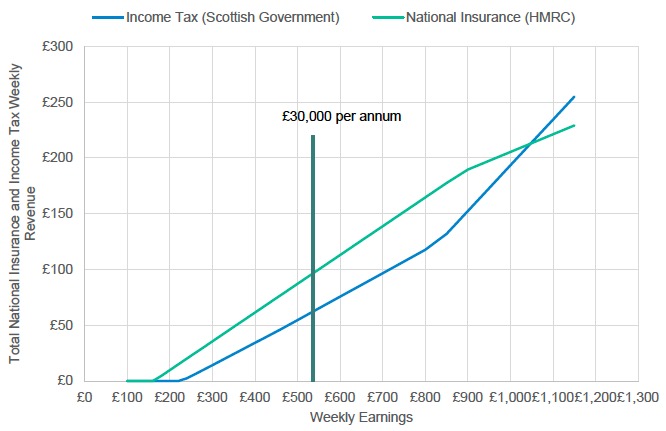UK immigration policy after leaving the EU: impacts on Scotland's economy, population and society
Debut report by independent Expert Advisory Group on Migration and Population looks specifically at how the ending of free movement and future UK Immigration policy will affect Scotland's devolved responsibilities.
4. Fiscal Effects
This chapter analyses the potential effects of reduced EU immigration to Scotland on Scotland's budget. Fiscal impacts are relevant to Scotland both because of the extensive spending powers already held by the Scottish Parliament and because of the new tax and welfare powers which it has assumed following the Scotland Act 2016.
4.1 Static and dynamic approaches to estimating fiscal impact
Reductions in EU migration to Scotland would affect Scotland's budget both by reducing tax revenues and by cutting demand for public services. The size of these effects will be determined by the overall change in net migration.
Analysis of fiscal impacts needs to begin with an evaluation of the current balance of migrant tax revenues and their use of public services in a given fiscal year – the so‑called static assessment. This contrasts with the dynamic or life cycle approach, where revenues and costs are viewed over the length of time the individual is expected to remain in the UK. Estimates of longer-term fiscal effects are reliant on strong assumptions about migrants' future tax contributions and their future use of public services. Note that the static approach treats the cost of educating children as part of the parent's public service costs. With the life-cycle approach, migrants and their children are treated separately.
A detailed analysis of both the static and dynamic approaches to estimating migrants' net fiscal impact was carried out for the MAC by Oxford Economics.[22] For the static analysis, it found that EU-15 migrants made an estimated net contribution of £3,740 to the UK fiscal balance in 2016-17, while EU-10 migrants made a net contribution of £1,040. In its dynamic analysis, the study found that EU migrants contributed a net £78,000 to the UK public finances, discounted over their lifetimes. The life-cycle contribution of EU and non-EU migrants who joined the UK labour market in 2016 was estimated to be £26.9 billion.
We were not able to carry out a similarly detailed analysis of the fiscal impacts of EU migrants in Scotland because of both time and data limitations. However, we were able to compare and contrast the characteristics of EU migrants in Scotland with those in the rest of the UK to derive broad conclusions about the applicability of the MAC analysis suitably scaled to Scotland. This discussion therefore concentrates on the relative impact of EU migrants on fiscal outcomes in Scotland compared with the rest of the UK.
First, we consider the relative magnitude of migrants' impact on tax revenues. Only around 8% of those currently resident in Scotland were born outside the UK. In the rest of the UK, this proportion is close to 16%. However, EU migrants make up a much larger proportion of Scotland's migrant population. While those born in the EU comprise 39% of migrants in the rest of the UK, they form 50% of Scotland's migrants. In 2017-18, EU migrants comprised 4.9% of the total Scottish population compared with 6.8% in the rest of the UK. Unless there are significant differences in net fiscal contributions at the individual level, this implies that the aggregate fiscal impact of EU migrants is smaller in Scotland than in the rest of the UK.
At the individual level, earnings are pivotal to the generation of both direct and indirect tax revenues. And since current earnings tend to be good predictors of future earnings, today's wages not only provide the basis for the static assessment of migrants' fiscal impact, they also drive the dynamic assessment. Table 4.1 shows estimates of average weekly earnings drawn from the Labour Force Survey over the period 2016-2018. The estimates cover those born in the UK, EU-15, EU-10 or other foreign-born nationals who are resident either in Scotland or in the rest of the UK.
Table 4.1: Average Weekly Earnings by Area of Birth and Residence (2016-2018)
| Scotland |
rUK |
|
|---|---|---|
| UK |
£478.60 |
£494.70 |
| non-EU |
£543.70 |
£627.90 |
| EU-15 |
£363.80 |
£401.30 |
| EU-10 |
£488.20 |
£544.20 |
Source: ONS Labour Force Survey 2016-18
Consistent with other data sources, the earnings of those born in the UK and resident in Scotland are around 3.3% lower than those born in the UK and resident elsewhere in the UK. The gap in migrant earnings is typically much larger, with those born in the EU-15 earning 13.3% less and those born in the EU-10 earning 9.3% less if resident in Scotland rather than in the rest of the UK. Lower earnings are likely to result in lower revenue generation, but the differential depends not only on the difference in mean earnings, but also their distribution. This distribution will interact with the Tier 2 salary limit to determine total tax revenues.
The range of taxes covered by the MAC assessment of the fiscal impact of migrants comprised income tax and national insurance, value-added tax, excise duties, fuel duties, air passenger tax, insurance premium tax, customs duties, betting taxes, vehicle excise and stamp duty on house purchases. The Scottish Government has a range of devolved tax responsibilities. Income tax, which is forecast to raise £11.7 billion in 2019-20, is by far the most important of these revenue sources.[23] Income tax collected from migrants resident in Scotland who are designated as 'Scottish taxpayers' by HMRC depends principally on their income, but will also be affected by their status (employed or self-employed), whether they are working, and by the size of any tax-free contributions that they make to, for example, pensions.
For the dynamic assessment, where an estimate is made of lifetime tax revenues, starting age plays an important role. Migrants who join a new workforce at the beginning of their working life can generate more tax revenues over their careers in the destination country than those who migrate later. As we saw in previous chapters, EU migrants to Scotland are typically younger than those who move to the rest of the UK. This is demonstrated in Figure 4.1, which shows the share of each age group in the relevant population by migrant status and area of residence. The data are drawn from LFS data, so it should be noted that the samples are small. It is apparent that EU-10 migrants to Scotland, with more than 30% of their number in the 16-29 age range, are younger both than the UK-born and other migrants.
Scotland has a larger share in this age range from both the EU-15 and the EU-10 migrant groups. Thus it is not surprising that the mean age of non-UK EU-15 migrants living in Scotland is 3.7 years less than those resident in the rest of the UK: the equivalent age gaps for EU-10 migrants is 1.7 years. If migrants, having arrived in Scotland at an earlier age compared with the rest of the UK, also stay longer (leaving at the same mean age as those in the rest of the UK), their lower levels of earnings will be somewhat offset in the dynamic assessment by their having an extended contribution period. However, there are no readily available statistics to enable comparisons of migrant lengths of stay across different parts of the UK.
Figure 4.1: Age Groups by Size, Area of Birth and Current Residence within UK

Source: ONS Labour Force Survey 2016-18
Age is also an important predictor of the use of public services. Health and social care expenditure, in particular, rises steeply with age. Figure 4.2 also shows that a lower proportion of migrants in Scotland are aged 65+. This migrant age group comprises 1.9% of the UK population, but only 0.7% of the Scottish population. Amongst those in employment or who are limited by health or disability in seeking work, a lower proportion in Scotland (23.8%) report health problems compared to the rest of the UK (26.3%). This again may reflect the younger mean age of migrants in Scotland. This broadly suggests that EU migrants to Scotland are less likely to place significant burdens on the health system compared with the rest of the UK.
In the static assessment, these differences may partly offset the effect of lower earnings on the net fiscal balance compared with the rest of the UK. The dynamic case is again uncertain in the absence of information on differences in mean migrant length of stay between Scotland and the UK.
Although EU migrants in Scotland may make less use of the health and social care systems, they may use other public services more intensively. Education is an obvious candidate. In the static analysis, the MAC approach is to focus on the 'accountable adult', whose usage of public services includes public service costs incurred by dependents. Given the age distribution of EU migrants, this will principally be children's consumption of education services. Household composition provides a first approximation to differences in levels of demand for education services. Figure 4.2 shows household composition by area of birth and area of residence within the UK. These estimates are derived from LFS data covering the period 2015-2018 to generate a large sample. Although there is a higher proportion of migrants to Scotland that are single or living as unrelated adults, the proportion of all migrants that are married or cohabiting with dependent children is exactly the same (37%) in Scotland as in rUK.
Figure 4.2: Household Composition by Area of Birth and Current Residence in UK

Source: ONS Labour Force Survey
Although this evidence is indirect and neglects issues such as differences in age and number of children, it suggests that there are unlikely to be substantial differences in the take-up of educational services between 'accountable adult' EU migrants in Scotland and those in the rest of the UK.
The general conclusion from this analysis is that the net fiscal contribution of EU migrants to Scotland is likely to be less positive than that for EU migrants across the UK as a whole. While the characteristics of EU migrants in Scotland and the rest of the UK are in many respects similar, lower wages in Scotland are likely to be the main driver of a lower net fiscal contribution. However, wages for the UK-born population are lower in Scotland than in the rest of the UK and hence the relative fiscal contribution of EU migrants is still likely to be positive.
4.2 Distribution of fiscal costs and benefits
We now consider how the fiscal costs and benefits of migration are shared between the Scottish and UK Governments. It is important to understand these costs because they reveal how the fiscal risks associated with migration are allocated between Scotland and the rest of the UK. Scotland differs from other parts of the UK in its extensive tax and welfare powers. It therefore bears more of the fiscal risk associated with migrant flows than do other parts of the UK.
Scotland acquired additional tax and welfare powers following the passing of the Scotland Act 2016. It already had wide spending responsibilities covering spending programs such as health, education and local government. The fiscal effects of net immigration to Scotland are shared between the two governments. Establishing the size and direction of these effects is complex.
Take, for example, tax revenues. Migrant National Insurance (NI), both employer and employee contributions, is retained by the UK Government. Migrant income tax, on the other hand, forms part of the Scottish Government's revenues. The major indirect tax, VAT, will soon be shared equally between the Scottish and UK Governments. Once the Scotland Act 2016 is fully implemented, the Scottish Government will raise around 40% of its total revenue.
Figure 4.4 shows how employers' and employees' combined contributions to NI and income tax will vary with weekly earnings during tax year 2019-20. At the proposed Tier 2 earnings limit of £30,000 per annum, migrants to Scotland and their employers would be paying around £70 per week in income tax and £105 per week in NI. Thus, at this level of income, migrants would be contributing slightly more in direct taxes to the UK Government than to the Scottish Government. However, contributions to the Scottish Government exceed those to the UK once earnings rise above £1,050 per week (£54,800 per annum).
Figure 4.4 Direct Taxation: Revenue Contributions to UK and Scottish Governments

Migration also has a more subtle effect on Scotland's revenues. By contributing to an increase in population, migrants affect Scotland's block grant allocation through the Barnett formula. This grant is adjusted upwards by Scotland's share of the UK population multiplied by any increase in UK Government spending on “comparable” programmes, such as health and education. Positive net migration adds to Scotland's share of the UK population and would increase its allocation from the UK Government so long as spending is increasing. A standstill in spending would mean that spending to cover public service use by migrants would be charged solely against Scottish Government tax revenues. We therefore suggest that analyses of the net fiscal effect of migration should take account of how migrants affect revenue raising and spending on public services at all affected levels of government.
Summary and Implications
An initial exploration of the fiscal impact of EU migrants in Scotland can only provide basic clues as to its direction. However, the evidence of differences between the volume and characteristics of migrants in Scotland compared to the rest of the UK are unlikely to substantially contradict the conclusions of the assessment of the fiscal impact for the UK carried out for the MAC. This would imply that EU migrants have a net positive fiscal impact on the Scottish economy. What has been established is that the volume of migrants in general, and EU migrants in particular, is relatively smaller in Scotland than in the rest of the UK. If, as the MAC study implies, migrants are making a positive contribution to the overall UK fiscal balance, increasing the volume of EU migrants to Scotland would boost tax revenues relative to public spending in both Scotland and the UK as a whole. Conversely, introducing the changes proposed in the White Paper would have a negative effect on this balance.
At the individual level, EU migrants earn less in Scotland than in the rest of the UK. This implies that tax revenues per head are likely to be lower. In turn, this implies that both the static and dynamic assessments of their individual fiscal contributions will be lower than for the UK as a whole. However, this effect may be somewhat offset by their younger age, which also has positive fiscal implications, at least in the static assessment, in relation to their lower demand for health and social care services compared with EU migrants in the rest of the UK. Finally, a rough assessment of the demands placed on educational services does not suggest substantive differences between Scotland and the rest of the UK.
Thus we are left with the tentative conclusion that EU migrants to Scotland make a positive fiscal impact. This may be somewhat less than the MAC estimated contributions of £3740 per head for the EU-15, and £1040 per head for the EU-10, in 2016-17, but is still likely to be significantly higher than the contribution made by the UK-born population, which the MAC estimates to be negative for the UK as a whole, at -£70 per head.[24]
However, we also noted the importance of understanding the distribution of revenue and expenditure associated with migrants between Scotland and the rest of the UK. While Scotland is responsible for providing migrants with many public services, it may only appropriate a portion of revenue from migrants. This implies the need for a more nuanced analysis of the spatial distribution of the fiscal benefits of immigration.
Contact
Email: Neil Meehan
There is a problem
Thanks for your feedback